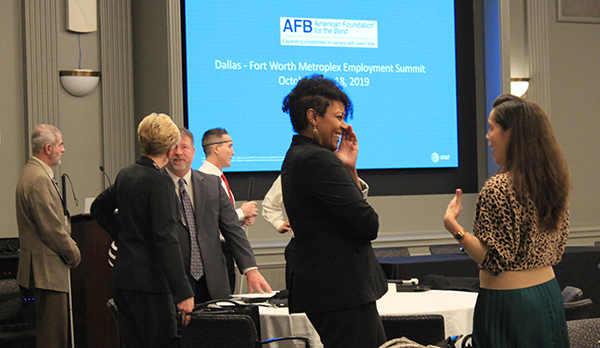
Over a two-day period falling roughly halfway through National Disability Employment Awareness Month, the American Foundation for the Blind held its second employment summit at AT&T’s Dallas headquarters.
Fifty-five influencers from various blindness organizations and companies interested in disability inclusion in the workplace participated in the invitation-only summit. Nine major companies were represented, including:
- AIG Life and Retirement
- Apple
- AT&T
- Bank of America
- Deloitte
- Fidelity Investments
- Oncor
- Southwest Airlines
- Toyota
The Texas Workforce Commission, Vocational Rehabilitation Services, sent 14 members of their top leadership from their headquarters in Austin and from the region. Fifteen local nonprofit organizations, government agencies, and foundations also participated, including:
- Ability Connection
- AbilityOne Commission
- American Foundation for the Blind
- Christal Vision
- Computers for the Blind
- Communities Foundation of Texas
- Criss Cole Rehabilitation Center
- Dallas Area Rapid Transit
- Envision Dallas Lighthouse for the Blind
- Lighthouse for the Blind Fort Worth
- National Employment Team of the Council of State Administrators of Vocational Rehabilitation
- National Research and Training Center on Blindness and Low Vision at Mississippi State University
- Texas Governor’s Committee on People with Disabilities
- Texas School for the Blind and Visually Impaired
- The University of North Texas
The day began with a presentation from William Lutz, economist from the Labor Market and Career Information Department of the Texas Workforce Commission, showing the robust economy in the Dallas–Fort Worth–Arlington statistical metropolitan area. The unemployment rate in this region is among the lowest in the country and there is high demand for workers, especially in the areas of information technology, healthcare, and financial services. The business case for including people with disabilities in the workforce was made, which included filling the gap for talent by recruiting qualified individuals with disabilities, and how including people with disabilities strengthens a business by adding diversity, creativity, and problem-solving skills, in addition to building a dedicated group of employees with low turnover.
Additional sessions included a variety of “lightning talks” from stakeholders across the employment ecosystem. Nonprofits involved in career training and placement discussed the programs they offer. A panel of professionals representing diversity and inclusion, recruiting, and accommodations from five corporations talked about their disability inclusion initiatives, how they recruit talent, and how they work with employees to ensure they have the accommodations necessary to allow them to perform their work at the highest level.
Four leaders from the Texas Workforce Commission, Vocational Rehabilitation Services, and the executive director of the Texas Governor’s Committee for People with Disabilities, discussed how they prepare people with visual impairments for the workforce, including helping develop appropriate skills in elementary, junior high, and high school; they also talked about how they can be a great source of recruitment for businesses seeking talent and how they can provide technical assistance related to job accommodations.
Attendees from the National Employment Team of the Council of State Administrators of Vocational Rehabilitation and the University of North Texas spoke about how to build strong relationships with businesses. Dallas Area Rapid Transit gave an overview of some of their programs to help area residents with disabilities commute to work. A panel of three leaders with visual impairments shared their stories of success, including how they found work and advanced in their careers.
Each presentation was followed by a brief question-and-answer session, and the first day wrapped with a lively networking reception hosted by Oncor.
The second part of the summit consisted of roundtable discussions to brainstorm on critical issues around increasing hiring and advancement opportunities for people with visual impairments. The summit concluded with the development of over a dozen potential action items that the group could collaborate on to positively impact employment opportunities and outcomes. As the summit concluded, all parties committed to holding quarterly conference calls, beginning with one in January to prioritize the action items from the summit and decide on the most effective path forward.
Feedback from attendees was positive and enthusiastic, and planning is already underway for the next summit.